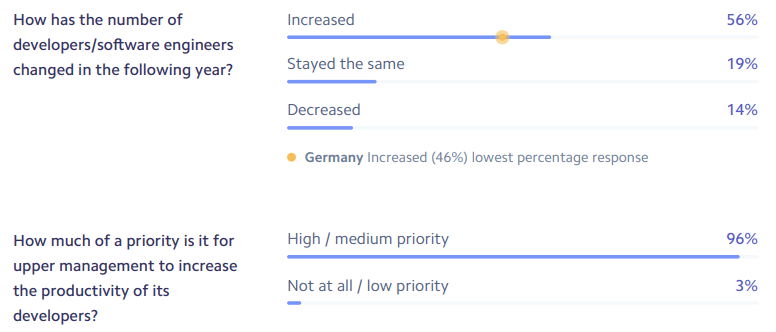GitLab - Huge Potential Value Generator - Part 2
Summary
Enterprises have gone through the cloud evolution, and are going through the DevOps evolution, but now they have fragmented DevOps tooling siloes.
GitLab offers enterprises cutting-edge DevOps tools all within a single platform - with incredible feature breadth.
If the agility and scalability provided by hyperscalers were the key value generators of the 2010s, .
We think the software management capabilities of leading DevOps names could be the biggest value generators of the 2020s.
Part 1 covered: rise of DevOps, the problems created, & GitLab's product and business model. Part 2 covers: the value, the future, the comp, and valuation.
The Value of DevOps and GitLab
Let’s say that the hyperscalers were the biggest value generators for enterprises during the 2010s. They provided the agility and scalability for orgs to better respond to market demand. However, as a by-product, the whole cloud paradigm (on-demand scale, containers, serverless, microservices, etc.) has generated huge amounts of complexity. Whereas legacy on-prem monolithic applications had inherent code complexity, cloud-native microservices-based applications have inherent operation complexity. Ultimately, this results in suboptimal productivity, a loss of cost control, and weakened security posture due to the various types of vulnerabilities that get exploited by bad actors.
Therefore, throughout the 2020s, we think it’s not unreasonable to surmise that the greatest value generators will be the vendors that can reduce the complexity: simplify DevOps operations, lower costs, increase productivity, and fortify security. Greater productivity unleashed via complexity reductions, will lead to enterprises fully realising the potential of the cloud computing paradigm. And GitLab is the number one vendor for this at present.
Another angle in which to consider the potential value that the likes of GitLab can unleash, is the economic textbook supply and demand curves. If an all-in-one DevOps platform can reduce complexity, and therefore deliver a step change in dev productivity, then any org will shift their software supply curve to the right. In turn, this will lower the costs of producing software, thus making it more affordable to software consumers, which causes them to consume more, and so a new cycle of economic growth begins.
Figure 13: Econ 101 – Increase in Productivity Shifts Supply Curve to the Right
Source: Convequity
Then, this can kickstart a virtuous cycle, whereby enterprises produce more software >>> more revenue >>> more profits >>> more reinvestment >>> hire more devs >>> more investment in DevOps vendors like GitLab. Which, in turn, generates another wave of productivity, and so on.
We strongly recommend subscribers take a look at this report by Stripe. It is now four years old, but the insights are set to have secular impacts on the technology industry. In short, Stripe’s survey findings discovered that C-level executives are more concerned with finding enough devs and engineers than they are with accessing capital. Four years later we hear the same narrative – a shortage of talent. And this is a structural shortage of talent imposed simultaneously by the pace of digitalisation and unmodernised education systems. Hence, it truly makes sense for orgs to begin thinking more about leveraging existing talent, rather than solely focusing on bringing in more.
For those with limited time, we shall share a few snippets of Stripe’s report below.
Figure 14: Business Threat Factors
As every technology enthusiast is well aware, COVID-19 has exacerbated many of these headwinds and the reliance on developers. If Stripe were to do the same survey again today, it is very likely that the responses would indicate an even greater need to extract more software quality and quantity from developer talent pools.
A major hindrance to dev productivity is technical debt overhang and poorly written (and annotated) code. The Stripe survey unveiled that devs spend a total of 17.3 hours per week on overcoming/rectifying these issues.
Figure 15: The Developer Work Week
As a result of the technical debt, bad code, and the disparate DevOps tooling, C-level executives and developers estimate devs are only about 68% productive (100% being the maximum).
Figure 16: Estimated Dev Productivity
Stripe sums up their report by estimating the annual economic loss from suboptimal dev productivity is $300bn – equating to $3tn over the next ten years (or since the report in 2018).
Figure 17: Economic Impact of Lost Dev Productivity
However, Stripe’s calculations appear to be incorrect, leading to an underestimation. If we say that the average dev work week is 40 hours (but any number will explain), then 27.4 hours of the week devs are being maximally productive. During the other 12.6 hours of the week, they are not working productive, or to be accurate, not working at all. Then, the calculation should be 40 / 27.4 – 1 = 0.46, or 46%; meaning if devs did become maximally productive throughout the entire 40-hour work week, then that would increase their productivity by 46%. And so, the economic loss estimate should be 46% * $918bn = $422bn.
This $422bn is the potential that can be claimed back on an annual basis if devs can become more productive. The major headwinds are culture, technical debt, legacy architectures, risk aversion, DevOps tool siloes, etc.; however, a comprehensive DevOps platform like GitLab can greatly assist in dissolving these barriers and lead DevOps teams to greater productivity.
There have been many numbers thrown around in this section, but the main takeaway is that GitLab has an opportunity to transform many enterprises, small and large, to deliver greater economic value, measured in the tens or hundreds of billions. It’s nigh-on impossible to estimate what percentage a mature-stage GitLab can extract as revenue from this, though, even single-digits would equate to large excess investor returns over a long-term timeframe.
One way to have a go at estimating a possible long-term ARR for GitLab is the following:
$1k per dev * 10 million devs = $10bn ARR
This would just be 2.3% of the $422bn in economic value potential derived from greater dev productivity. When we consider this, it makes us think that $10bn ARR could be the eventual long-term lower bound.
Future of DevOps & GitLab
It looks as though the biggest long-tail areas of growth for DevOps are: the platform model, software supply chain security, ML automation, and analysis and metrics.
Platform Model
For a few years now, the platform model to DevOps has received increasing attention. The key characteristics of a DevOps platform are:
A seamless end-to-end application lifecycle support
The entire CI/CD workflows incorporated into a single application
Shared self-service functionalities for devs and ops engineers
The self-service component is becoming increasingly important, as it enables devs to provision things with a few clicks, instead of heavy-lift configurations or waiting for an ops engineer to do something.
The State of DevOps 2021 report by Puppet offers a lot of insight into developments relating to orgs transitioning to DevOps. Via their methodology, Puppet categorised cloud-using orgs as high, mid, or low DevOps evolution entities. They found that 78% fell into the mid category, and therefore they decided to probe deeper into this category. They discovered the key difference between those orgs that were high-mid and those that were low-mid, was that the former had implemented a platform model for managing their DevOps.
The report doesn’t explicitly state whether those orgs that had implemented a platform model, had completely developed it in-house, or whether they received assistance from third-party DevOps platforms (like GitLab), or whether the entirety of the platform was a third-party DevOps platform. From our research, even if DevOps teams are choosing to implement the platform model in-house, it is unlikely to be as feature-rich, scalable, seamless, and sustainable as a platform solution like GitLab’s. As aforementioned, the costs of maintaining an internal DevOps platform model are high. It involves searching for limited talent, paying high salaries, training, and overheads, and on the whole just requires huge resources to emulate anything close to what GitLab offers. Only giants like GOOGL and META have been able to afford to do something like an internal DevOps platform and make it part of their competitive edge. E.g., internal tools like Kubernetes were used within GOOGL for years before it was open sourced.
Gartner also aligns to this outlook. By 2023, they predict that 40% of orgs will have moved away from in-house DIY approaches involving multiple solutions, toward a platform model, coined the Value Stream Delivery Platform (VSDP).
Figure 18: GitLab’s All-in-One DevOps Platform
We shall summarise the Platform Model, or VSDP, section with the following diagrams. Both diagrams show the problem-solution evolution since the advent of cloud computing. Right now, to reduce complexity and increase productivity in a cost-effective way, the VSDP appears to be the way forward.
Figure 19: The Backstory to Why Orgs Now Need VSDPs (1)
Source: Convequity
Figure 20: The Backstory to Why Orgs Now Need VSDPs (2)
Source: Convequity












